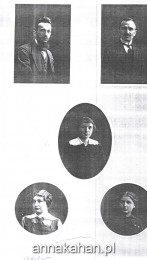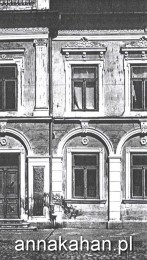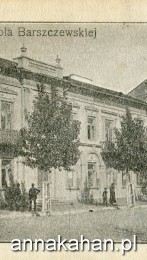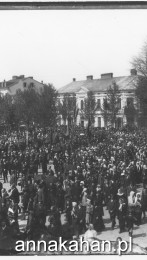[Jadwiga Barszczewska School]
Anna’s very religious father was opposed to her attendance at the Russian Secondary School for Girls, because its pupils had to attend classes also on Saturday, the Sabbath day. Consequently, the tutor from that school was dismissed and a new one, Teresa Cukier, a student from the Jadwiga Barszczewska School of Business for Girls was hired. Her father chose this school because its Jewish pupils were allowed to miss classes on Saturdays. In the first year of the school’s operation, there were four Poles and three Jewish girls on the list.
At the beginning, the school was located at 40 Ogrodowa Street in a building that no longer exists. The house was destroyed during the Second World War. House numbering; however, would be consistent with the current numbering. Therefore, it would be the third building from the corner house of Jadwiga Orzechowska, located at the current 34 Sienkiewicz Street, exactly opposite of today’s Władysław Broniewski Primary School No. 6.
The founder of the school, despite her young age, was a very energetic woman and determined to implement her plans. As the first woman in Siedlce – which may sound quite strange today – she had her own women’s bike and fought with boys for a women’s right to ride a bicycle on the market square near the prison. She finished her studies in Petersburg with a gold medal. This achievement although minor, allowed her to obtain a licence from the Ministry of Finance to establish in Siedlce a business school for girls.
In early May 1904, after obtaining a licence, she went to Finland to learn about the leading education system in Europe. Meanwhile, her father was employing teachers, making furniture, gathering teaching aids, and preparing the building for the opening of the school.
The new school was opened in early September 1904. This very young owner was often younger than her pupils. She spoke several languages fluently. She also taught prohibited subjects, geography and the history of Poland. By introducing school gymnastics and medical examinations, she stayed ahead of the contemporary European education. Her father, a famous traveller and researcher of the Central Asia area, combined his passions with a talent for teaching and organized sightseeing trips for the pupils.
At the beginning, the school had four classes, and then from 1907 it had seven. In the school year 1910/1911, it was transformed into an eight-class school and in 1916/1917 into the Secondary (Real) School for Girls. The school motto was “Truth and Work”. Jadwiga Barszczewska wanted her pupils to be brave, strong, fair, ambitious, and love Poland deeply.
In the school year 1916/1917, it was moved to an abandoned building of the Russian Pre-Gymnasium for Girls on 4 Długa Street (currently Bishop Świrski Street). Owing to the fact that Jadwiga Barszczewska handed the school over to the State on May 14, 1919, the school has been running continuously ever since under the name of the Saint Queen Hedwig Secondary School No. 2 and is now located at Bolesław Prus Street. Until 1939, it operated as the Queen Hedwig State Gymnasium for Girls. At that time, it was the only secondary school for girls, which was not private.
The teaching team was made up of people who were important in the history of Siedlce. Jadwiga Brodzińska, a Polish language teacher, was the owner of the second Polish reading room in the history of Siedlce. Jan Komar, a drawing teacher, was also the author of the Independence and Freedom monuments. Mieczysław Asłanowicz, an Arminian by birth, the head master of the Podlaski Gymnasium and later of the Hetman Stanisław Żółkiewski State Secondary School for Boys, started his teaching career in this school. Wacław Szwedowski, the owner of the Private Modern Secondary School for Boys, and from December 28, 1926 the President of the City Council was also among the teachers.
In 1915, Anna Kahan was preparing to study at this school, which at that time operated as the Jadwiga Barszewska Business School in Siedlce. Its graduates received a school completion certificate in three languages: Polish, French, and Russian.
We go to the other side of Sienkiewicz Street and go back to the roundabout where there is a Garrison Church. We turn right and go down Kiliński Street. Soon, we reach the next roundabout, which is a junction with 3 Maja Street, formerly known as Stodolna Street.









